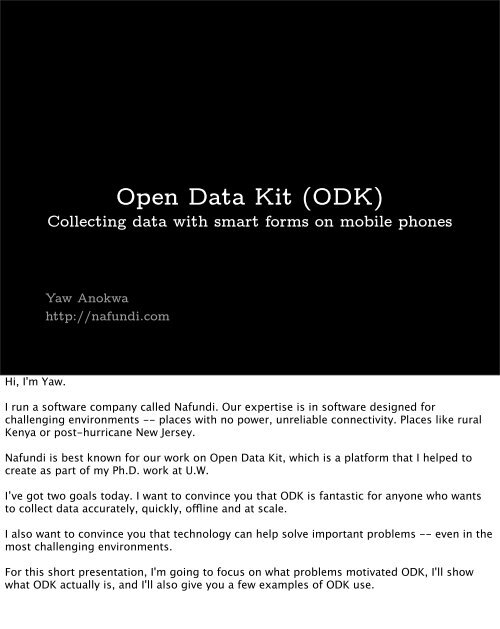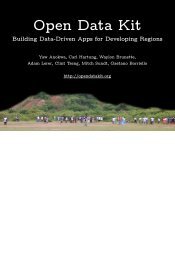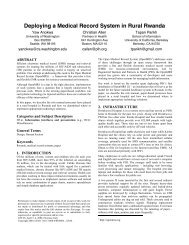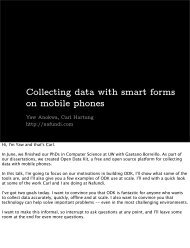Open Data Kit (ODK) - Yaw Anokwa
Open Data Kit (ODK) - Yaw Anokwa
Open Data Kit (ODK) - Yaw Anokwa
Create successful ePaper yourself
Turn your PDF publications into a flip-book with our unique Google optimized e-Paper software.
Hi, I'm <strong>Yaw</strong>.<br />
<strong>Open</strong> <strong>Data</strong> <strong>Kit</strong> (<strong>ODK</strong>)<br />
Collecting data with smart forms on mobile phones<br />
<strong>Yaw</strong> <strong>Anokwa</strong><br />
http://nafundi.com<br />
I run a software company called Nafundi. Our expertise is in software designed for<br />
challenging environments -- places with no power, unreliable connectivity. Places like rural<br />
Kenya or post-hurricane New Jersey.<br />
Nafundi is best known for our work on <strong>Open</strong> <strong>Data</strong> <strong>Kit</strong>, which is a platform that I helped to<br />
create as part of my Ph.D. work at U.W.<br />
I’ve got two goals today. I want to convince you that <strong>ODK</strong> is fantastic for anyone who wants<br />
to collect data accurately, quickly, offline and at scale.<br />
I also want to convince you that technology can help solve important problems -- even in the<br />
most challenging environments.<br />
For this short presentation, I'm going to focus on what problems motivated <strong>ODK</strong>, I'll show<br />
what <strong>ODK</strong> actually is, and I'll also give you a few examples of <strong>ODK</strong> use.
Collecting data in places with no infrastructure is hard.<br />
Collecting data in places with no infrastructure is really hard.<br />
This is a village on the edge of Lake Victoria in Eastern Uganda I worked in.<br />
I think it’s a good example of the places where groups like Doctors without Borders needs to<br />
provide services.<br />
You can see in a place like this there is almost no infrastructure. No good roads. No running<br />
water. No electricity.<br />
So if for example, Doctors Without Borders needs to do a survey in this area to find out where<br />
illness are, how will they do that?
Paper is common practice, but limits scale and impact.<br />
They will use paper. This is common practice but it really limits your scale.<br />
If I want to find out how many people in these forms shown here have malaria, that’s hard to<br />
accurately.<br />
If I want to map where an outbreak is occurring in realtime, that’s even harder.<br />
And imagine doing this across an entire region from paper records.<br />
Basically impossible because all this useful data isn’t digitized. It’s trapped on paper and that<br />
isn’t scaleable.<br />
These problems where driving motivation behind my Ph.D. work addressing these limitations<br />
of paper through technology.<br />
That’s why <strong>ODK</strong> was created.
<strong>ODK</strong> replaces paper forms with smart forms on phones.<br />
1. Build form 2. Collect data 3. Aggregate results<br />
<strong>ODK</strong> replaces paper forms with smart forms on a phone or tablet. <strong>ODK</strong> provides an out-ofthe-box<br />
solution for users to:<br />
1. Build a data collection form;<br />
2. Put that form and a mobile device to collect that data;<br />
3. Send that data to a server where the results are aggregated;<br />
It's great for mobile workers (e.g., census takers, community health workers, building<br />
inspectors) who need to collect data accurately and report results instantly.<br />
And the best part? It’s completely free and open source.<br />
Let me show you what it looks like.
<strong>ODK</strong> Build: Design your form using drag and drop.<br />
<strong>ODK</strong> Build is an web application where you drag and drop prompts to create forms.<br />
And so the form will have these four questions.
<strong>ODK</strong> Collect: Display prompts for data collection.<br />
When you give the form to <strong>ODK</strong> Collect on the phone, it looks like this.<br />
You can collect text, numbers, dates.<br />
To improve accuracy, you can put validation checks on all prompts. So for example, birth<br />
dates can’t be in the future.<br />
You can also capture GPS location using one click.
<strong>ODK</strong> Collect: Form logic used for multimedia and diagnosis.<br />
The forms themselves are really powerful. So here is an example of IMCI in swahili.<br />
IMCI is the integrated management of childhood illnesses. It’s basically a triage protocol for<br />
children under five.<br />
My Swahili is weak, so let’s switch to English. With <strong>ODK</strong> Collect you can do this on the fly.<br />
And if I enter that the child is coughing and has a fever, in the next screen, I can record the<br />
sound of the cough and then I can show the nurse a video about how to treat fever.<br />
And as the nurse use the form, it can take the inputs and figure out a likely diagnosis and<br />
treatment. It’s pretty powerful stuff.<br />
Any data I gather can be stored offline and then be sent off to a server.<br />
So where does the data go?
<strong>ODK</strong> Aggregate: Store data locally and on the cloud.<br />
<strong>ODK</strong> Aggregate hosts the submitted data locally or in the cloud.<br />
We don’t run one big server, you download an installer, and it configures one for you locally<br />
or on the cloud.<br />
It can provide interfaces such as spreadsheets for you to get your data out.
<strong>ODK</strong> Aggregate: Stream data to other systems.<br />
<strong>ODK</strong> Aggregate can also stream your data to other systems, like Google Earth.<br />
In this example, forestry workers with the Jane Goodall Institute in Tanzania, submitted data<br />
from Collect to Aggregate and then exported to Google Earth.<br />
Managers could then click on each yellow point and get the data that was submitted.
1. Build form 2. Collect data 3. Aggregate results<br />
So that’s what <strong>ODK</strong> is. A platform that will help you build a form, collect data, and aggregate<br />
some results.<br />
Now that’s nice and all, but when people find out that this came out of an academic research<br />
project, they start asking if the software actually works.<br />
Well, yeah! We have 10s of thousands of users. Let me give you some examples.<br />
The thing I want to stress here is that these most of these projects found and deployed <strong>ODK</strong><br />
by themselves.
Kiva uses <strong>ODK</strong> to get borrower information.<br />
I think most people know about Kiva. They do micro-finance.<br />
A few Kiva partners collect data using <strong>ODK</strong>. So when you see pictures and borrower<br />
information, some of that was collected using <strong>ODK</strong>.
Carter Center uses <strong>ODK</strong> for monitoring elections.<br />
Carter Center uses <strong>ODK</strong> for monitoring elections.<br />
So if you remember the Egyptian elections, Jimmy Carter was there, and he and his team used<br />
<strong>ODK</strong> to collect and report data.
Carbon For Water collected over 1,000,000 forms<br />
with 4,000 <strong>ODK</strong>-powered phones in 6 weeks.<br />
Carbon For Water collected over 1,000,000 forms with 4,000 <strong>ODK</strong>-powered phones in 6<br />
weeks. This was to track and monitor water filtration devices.<br />
At their peak they were doing 40k forms a day! 40k images a day. 40k GPS locations a day.<br />
Pretty incredible.
AMPATH’s health workers have used <strong>ODK</strong> to<br />
counsel and test over 775,000 people for HIV.<br />
AMPATH’s health workers have used <strong>ODK</strong> to counsel and test over 775,000 people for HIV<br />
over the last 2 years.<br />
<strong>ODK</strong> helps the counselors collect socio-economic data.<br />
The phone also helps counselors decide if someone, based on their answers, is at risk for for<br />
HIV and if they should be tested.
I want to use RHVouchers as a last example. These guys made a video, so I will just show<br />
that.<br />
http://youtube.com/watch?v=0vw_5sVYj-A
Collecting data accurately and quickly on paper is difficult.<br />
<strong>ODK</strong> replaces paper forms with smart forms on phones.<br />
1. Build form 2. Collect data 3. Aggregate results<br />
So summarize.<br />
http://opendatakit.org (@opendatakit)<br />
http://nafundi.com (@nafundi)<br />
Using paper to collect data is difficult and inefficient.<br />
<strong>ODK</strong> replaces paper forms with smart forms on a phone or tablet. <strong>ODK</strong> provides an out-ofthe-box<br />
solution for users to:<br />
1. Build a data collection form;<br />
2. Use mobile device to collect that data;<br />
3. Aggregate the collected data on a server;<br />
It's great for mobile workers who need to collect data accurately and report results instantly.<br />
Besides collecting text and numbers, <strong>ODK</strong> can be used to take pictures, capture GPS location,<br />
scan barcodes, get signatures, and even play videos. <strong>ODK</strong> supports branching logic,<br />
repeating sections, multiple languages, and data encryption.<br />
And the best part is that it’s free and open source.





